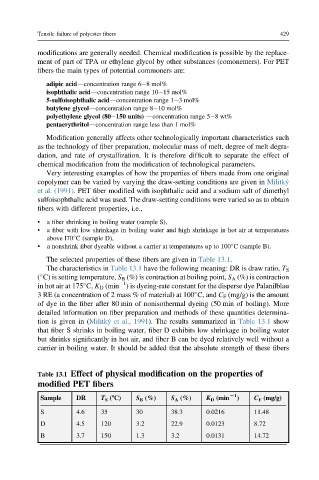Page 456 - Handbook of Properties of Textile and Technical Fibres
P. 456
Tensile failure of polyester fibers 429
modifications are generally needed. Chemical modification is possible by the replace-
ment of part of TPA or ethylene glycol by other substances (comonemers). For PET
fibers the main types of potential commoners are:
adipic aciddconcentration range 6e8 mol%
isophthalic aciddconcentration range 10e15 mol%
5-sulfoisophthalic aciddconcentration range 1e3 mol%
butylene glycoldconcentration range 8e10 mol%
polyethylene glycol (80e150 units) dconcentration range 5e8 wt%
pentaerythritoldconcentration range less than 1 mol%
Modification generally affects other technologically important characteristics such
as the technology of fiber preparation, molecular mass of melt, degree of melt degra-
dation, and rate of crystallization. It is therefore difficult to separate the effect of
chemical modification from the modification of technological parameters.
Very interesting examples of how the properties of fibers made from one original
copolymer can be varied by varying the draw-setting conditions are given in Militký
et al. (1991). PET fiber modified with isophthalic acid and a sodium salt of dimethyl
sulfoisophthalic acid was used. The draw-setting conditions were varied so as to obtain
fibers with different properties, i.e.,
• a fiber shrinking in boiling water (sample S),
• a fiber with low shrinkage in boiling water and high shrinkage in hot air at temperatures
above l70 C (sample D),
• a nonshrink fiber dyeable without a carrier at temperatures up to 100 C (sample B).
The selected properties of these fibers are given in Table 13.1.
The characteristics in Table 13.1 have the following meaning: DR is draw ratio, T S
( C) is setting temperature, S B (%) is contraction at boiling point, S A (%) is contraction
1
in hot air at 175 C, K D (min ) is dyeing-rate constant for the disperse dye Palanilblau
3 RE (a concentration of 2 mass % of material) at 100 C, and C F (mg/g) is the amount
of dye in the fiber after 80 min of nonisothermal dyeing (50 min of boiling). More
detailed information on fiber preparation and methods of these quantities determina-
tion is given in (Militký et al., 1991). The results summarized in Table 13.1 show
that fiber S shrinks in boiling water, fiber D exhibits low shrinkage in boiling water
but shrinks significantly in hot air, and fiber B can be dyed relatively well without a
carrier in boiling water. It should be added that the absolute strength of these fibers
Table 13.1 Effect of physical modification on the properties of
modified PET fibers
Sample DR T S (8C) S B (%) S A (%) K D (min L1 ) C F (mg/g)
S 4.6 35 30 38.3 0.0216 11.48
D 4.5 120 3.2 22.9 0.0123 8.72
B 3.7 150 1.3 3.2 0.0131 14.72

